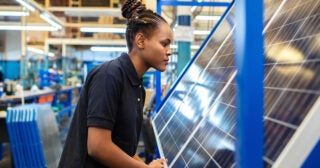- Resources
- Leading companies are using IRA tax credits for clean manufacturing and technology. Are you?
Resources
Leading companies are using IRA tax credits for clean manufacturing and technology. Are you?
Published: June 7, 2023 by Elizabeth Sturcken
Any company that owns or sources from industrial facilities may benefit from Inflation Reduction Act (IRA) incentives. Two key provisions have the potential to be game-changing for U.S. renewables manufacturers and for businesses that invest in energy efficiency and emissions reductions in industrial facilities.
First, the Advanced Manufacturing Production Credit (§45X) provides a tax credit for domestically manufactured or assembled renewables equipment, such as components for solar and wind energy, certain battery components, inverters and critical minerals.
Second, the Advanced Energy Project Credit (§48C) incentivizes investments in clean energy manufacturing by providing businesses with a tax credit of up to 30 percent. It covers a variety of investments (including energy efficiency and GHG reduction retrofits) in manufacturing facilities and capabilities, such as energy storage systems, grid modernization equipment, as well as critical minerals processing and recycling.
These IRA tax credits are expected to greatly expand the country’s renewables manufacturing capacity and increase demand for clean technology – benefiting both U.S. renewables manufacturers and companies that own or source from industrial facilities.
Bottomline: the provisions are good for profit and for the planet. They can also help companies make tangible progress towards meeting their climate commitments.
That’s why businesses across the board are already taking advantage of these IRA tax incentives. Here’s a sampling of what some leading companies are already doing – and how others can take advantage, too.
Leading companies are jumping in: Battery joint ventures, wind power on-shoring and biofuel production
Earlier this year, Ford Motor Company announced an investment of $3.5 billion to build a lithium iron phosphate (LFP) electric vehicle battery plant in Marshall, Michigan. In its Q3 2022 earnings call, Ford CEO Jim Farley referred to the Advanced Manufacturing Production Credit with $45 per kilowatt per hour as the Company’s largest opportunity in the IRA.
Novozymes Blair, Inc received $28.4 million to install equipment at a new manufacturing facility in Blair, Nebraska. The facility produces enzymes used in manufacturing cellulosic ethanol from corn stover by the biochemical platform (e.g., biomass pretreatment, enzymatic hydrolysis, fermentation) to then manufacture biofuel.
Foreign manufacturers of wind power components have also announced investments in US manufacturing capabilities to effectively respond to the IRA and become eligible for its incentives. For example, Spanish-German company Siemens Gamesa announced a wind turbine nacelle manufacturing plant investment of $500 million in New York.
Additionally, Nikola Corporation has shared how the IRA provisions will benefit the company’s vehicle and components production. For example, the Advanced Energy Project Credit will help the company expand manufacturing facilities for the production of heavy-duty battery EVs and FCEVs. Nikola also may benefit from $10 per kilowatt hour if it begins producing battery modules in-house.
Solar, wind turbine and HVAC manufacturing
In August 2022, First Solar, Inc. announced plans to invest up to $1.2 billion in the U.S. to scale domestic manufacturing of photovoltaic modules. The plan includes a vertically integrated domestic factory in Lawrence County, Alabama. The company credits the manufacturing and production tax incentives in the IRA for providing the necessary long-term clarity for U.S. manufacturing investments.
American Industrial Transport (formerly American Railcar Industries) received $5.3 million in IRA funding to re-equip a rail car manufacturing plant for the production of 500 structural steel towers per year for large-scale commercial wind turbines in Fort Dodge, Iowa.
AAF-McQuay Inc. also received $1.3 million in funding for a building in Fairbault, Virginia to re-equip a manufacturing facility for the production of rooftop air conditioning systems used on HVAC systems.
Roadmap to the advanced manufacturing provisions
While these businesses are all benefitting from the IRA, navigating the complexities of the advanced manufacturing provisions can be overwhelming and confusing – no matter what business function gets involved.
That’s why EDF created a roadmap to help companies get started. The new IRA Activation Guide: Advanced Manufacturing includes essential and digestible information on the Advanced Manufacturing Production Credit (§45X) and the Advanced Energy Project Credit (§48C).
In the guide, companies can also find a list of eligibility requirements, instructions on how to claim the credits and important due dates for action.
Regardless of a company size or its progress on sustainability, it’s clear that these provisions make good sense – economically and environmentally. The time to take advantage is now.

